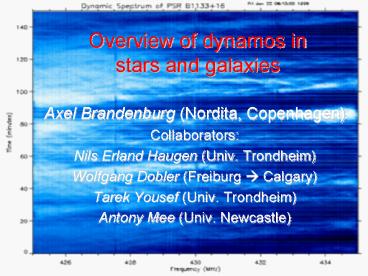Overview of dynamos in stars and galaxies - PowerPoint PPT Presentation
1 / 26
Title:
Overview of dynamos in stars and galaxies
Description:
Overview of dynamos in stars and galaxies. Axel Brandenburg (Nordita, ... Fuchs et al (1999) Fuchs et al (1999) Blackman & B (2002) Blackman & Field (2004) ... – PowerPoint PPT presentation
Number of Views:37
Avg rating:3.0/5.0
Title: Overview of dynamos in stars and galaxies
1
Overview of dynamos in stars and galaxies
- Axel Brandenburg (Nordita, Copenhagen)
- Collaborators
- Nils Erland Haugen (Univ. Trondheim)
- Wolfgang Dobler (Freiburg ? Calgary)
- Tarek Yousef (Univ. Trondheim)
- Antony Mee (Univ. Newcastle)
2
Dynamos
kinematic
laminar fast and slow
turbulent large-scale and small -scale
nonlinear
self-killing
self-generating
quenching
J.B-driven
Fuchs et al (1999)
Fuchs et al (1999)
Blackman B (2002)
Blackman Field (2004)
3
MRI Local disc simulations
Dynamo makes its own turbulence (no longer
forced!)
Hyperviscosity 1283
4
Important questions
w/ shear w/ rotation
- Does SN turbulence give dynamo?
- Resolution too poor? Or because of shocks?
- How important is compressibility?
- Does the turbulence become acoustic?
- Is turbulent B-field a small scale feature?
- PPM, hyperviscosity, shock viscosity, etc
- Can they screw things up?
- Bottleneck effect (real or artifact?)
- Does the actual Prandtl number matter?
- We are never able to do the real thing
Fundamental questions ? more idealized
simulations
Korpi et al (1999) Sarson et al (2003)
5
1st Problem compressibility?
Shocks sweep up all the field dynamo harder?
-- or artifact of shock diffusion?
Direct and shock-capturing simulations, n/h1
Direct simulation, n/h5
? Bimodal behavior!
6
Potential flow subdominant
Potential component more important, but remains
subdominant
Shock-capturing viscosity affects only small
scales
7
Flow outside shocks unchanged
Localized shocks exceed color scale
Outside shocks smooth
8
2nd problem small-scale dynamo
Kazantsev (1968)
According to linear theory, field would be
regenerated at the resistive scale
Magn. spectrum
Kin. spectrum
Maron Cowley (2001)
magnetic peak resistive scale?
9
Kazantsev spectrum (kinematic)
Opposite limit, no scale separation, forcing at
kf1-2
Kazantsev spectrum confirmed (even for n/h1)
Spectrum remains highly time-dependent
10
256 processor run at 10243
-3/2 slope?
Haugen et al. (2003, ApJ 597, L141)
Result not peaked at resistive scale -- Kolmogov
scaling!
instead kpeakRm,crit1/2 kf 6kf
11
3nd problem deviations from Kolmogorov?
compensated spectrum
Porter, Pouquet, Woodward (1998) using PPM,
10243 meshpoints
Kaneda et al. (2003) on the Earth simulator,
40963 meshpoints (dashed Pencil-Code with 10243 )
12
Comparison hyper vs normal
height of bottleneck increased
Haugen Brandenburg (PRE, 2004)
onset of bottleneck at same position
2nd Result inertial range unaffected by
artificial diffusion
13
Helical MHD turbulence
- Helically forced turbulence (cyclonic events)
- Small large scale field grows exponentially
- Past saturation slow evolution
- ? Explained by magnetic helicity equation
14
Slow saturation
Brandenburg (2001, ApJ)
15
Connection with a effect writhe with internal
twist as by-product
clockwise tilt (right handed)
W
? left handed internal twist
Yousef Brandenburg AA 407, 7 (2003)
16
Revised nonlinear dynamo theory(originally due
to Kleeorin Ruzmaikin 1982)
Two-scale assumption
Production of large scale helicity comes at the
price of producing also small scale magnetic
helicity
17
Express in terms of a
? Dynamical a-quenching (Kleeorin Ruzmaikin
1982)
no additional free parameters
Steady limit consistent with Vainshtein
Cattaneo (1992)
(algebraic quenching)
18
History of a quenching
catastrophic a quenching Rm dependent
(Vainshtein Cattaneo
1972, Gruzinov Diamond 1994-96)
conventional a quenching e.g., aB-3,
independent of Rm (Moffatt 1972, Rüdiger 1973)
periodic box simulations saturation at
super-equipartition, but after resistive
time (Brandenburg 2001)
open domains removal of magnetic waste by
helicity flux (Blackman Field 2000, Kleeorin et
al 2000-2003)
Dynamical quenching
Kleeorin Ruzmaikin (1982)
19
Current helicity flux
- Advantage over magnetic helicity
- ltj.bgt is what enters a effect
- Can define helicity density
Rm also in the numerator
20
Full time evolution
Significant field already after kinematic growth
phase
followed by slow resistive adjustment
21
Large scale vs small scale losses
Diffusive large scale losses ? lower saturation
level (Brandenburg Dobler 2001)
Periodic box
with LL losses
Small scale losses (artificial) ? higher
saturation level ? still slow time scale
Numerical experiment remove field for kgt4 every
1-3 turnover times (Brandenburg et al. 2002)
22
Significance of shear
- a ? transport of helicity in k-space
- Shear ? transport of helicity in x-space
- Mediating helicity escape (? plasmoids)
- Mediating turbulent helicity flux
Expression for current helicity flux
(first order smoothing, tau approximation)
Schnack et al.
Vishniac Cho (2001, ApJ)
Expected to be finite on when there is shear
Arlt Brandenburg (2001, AA)
23
Simulating solar-like differential rotation
- Still helically forced turbulence
- Shear driven by a friction term
- Normal field boundary condition
24
Helicity fluxes at large and small scales
Negative current helicity net production in
northern hemisphere
1046 Mx2/cycle
25
Impose toroidal field ? measure a
previously
26
Conclusions
- Homogeneous dynamos saturate resistively
- Entirely magnetic helicity controlled
- Inhomogeneous dynamo
- Open surface, equator
- Still many issues to be addressed
- Current helicity flux important
- Finite if there is shear
- Avoid magnetic helicity, use current helicity































